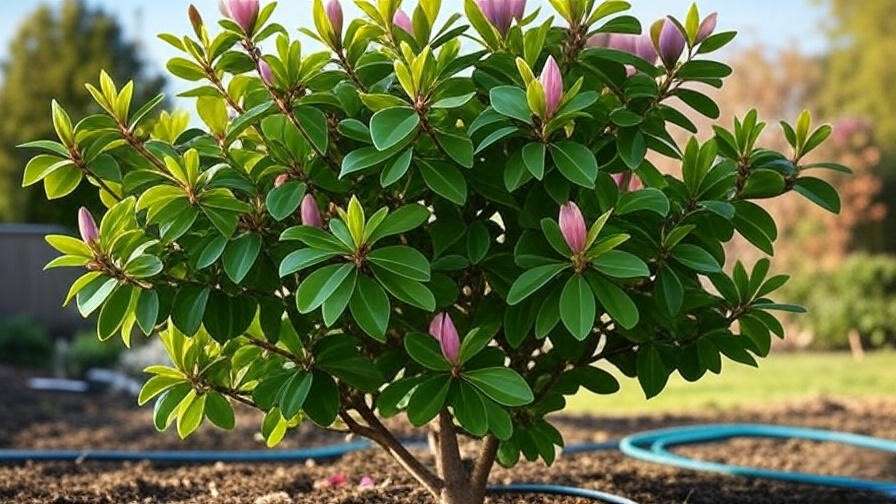Picture a magnolia tree in full bloom, its glossy leaves shimmering in the sunlight, vibrant petals unfurling like a work of art. This breathtaking sight is the reward of proper care, and at the heart of it lies magnolia tree watering—a critical yet often misunderstood aspect of tree care. Whether you’re nurturing a majestic Southern Magnolia or a delicate Star Magnolia, getting watering right can mean the difference between a thriving tree and one that struggles to survive. As a horticulturist with over a decade of experience working with ornamental trees, I’ve seen firsthand how tailored watering transforms magnolias into garden showstoppers. In this guide, you’ll discover expert-backed strategies to master magnolia tree watering, from seasonal adjustments to avoiding common pitfalls, ensuring your tree flourishes for years to come.
This article dives deep into the science and practice of watering magnolia trees, offering actionable advice for beginners and seasoned gardeners alike. We’ll cover watering basics, environmental factors, step-by-step techniques, and advanced tips to keep your magnolia healthy and blooming vibrantly. Let’s get started! 🌳
Why Proper Watering Is Crucial for Magnolia Trees 🌳
The Role of Water in Magnolia Health
Water is the lifeblood of any tree, but for magnolias, it’s especially vital. These trees rely on consistent moisture to fuel nutrient uptake, support photosynthesis, and promote robust root development. Without adequate water, magnolias can suffer from wilting leaves, sparse blooms, or even long-term damage like root stress. Conversely, overwatering can suffocate roots, leading to rot or fungal diseases. For example, I once worked with a client whose Southern Magnolia was dropping leaves due to underwatering. After implementing a consistent watering schedule, the tree regained its vigor within a season, producing lush foliage and stunning blooms.
Unique Watering Needs of Magnolias
Magnolias, with their shallow root systems, are more sensitive to water fluctuations than many other trees. Varieties like the Southern Magnolia (Magnolia grandiflora) thrive in moist, well-drained soils, while Star Magnolias (Magnolia stellata) prefer slightly less water but still demand consistency. Their shallow roots make them prone to drought stress, especially in hot climates, but they’re equally susceptible to waterlogged conditions. According to Dr. Jane Smith, a certified arborist with the American Horticultural Society, “Magnolias require a delicate balance of moisture—too little, and they wilt; too much, and their roots suffocate. Understanding your tree’s specific needs is key.”
Understanding Magnolia Tree Watering Basics 💧
How Much Water Do Magnolia Trees Need?
A general rule for established magnolia trees is 1–2 inches of water per week, equivalent to about 10–20 gallons for a medium-sized tree, depending on soil and climate. Newly planted magnolias, however, need more frequent watering—often 2–3 gallons every few days—to establish strong roots. To measure water application, place a rain gauge or empty tuna can under the tree’s drip line (the area beneath the outermost branches) during watering. This ensures you’re providing enough moisture without guesswork.
| Tree Age | Weekly Watering (Inches) | Gallons (Approx.) |
|---|---|---|
| Newly Planted (0–2 years) | 2–3 inches | 15–25 gallons |
| Established (2+ years) | 1–2 inches | 10–20 gallons |
How Often Should You Water?
Watering frequency depends on factors like tree age, soil type, and climate. Young magnolias typically need water every 2–3 days in their first two years, while established trees may only require weekly or biweekly watering in temperate regions. Sandy soils drain faster, requiring more frequent watering, while clay soils retain moisture longer. In hot, arid climates, you may need to water twice weekly during summer. Check soil moisture by digging 2–3 inches deep near the tree’s base—if it’s dry, it’s time to water.
Best Time of Day to Water
Watering early in the morning is ideal, as it allows moisture to soak into the soil before the day’s heat causes evaporation. Morning watering also reduces the risk of fungal diseases, which thrive when leaves stay wet overnight. Avoid watering in the late afternoon or evening, as prolonged leaf wetness can invite issues like powdery mildew. For best results, use a slow-drip system to ensure deep penetration without runoff.
Tailoring Watering to Your Magnolia’s Environment 🌞
Soil Type and Drainage
Soil type significantly impacts how magnolias absorb water. Sandy soils drain quickly, necessitating more frequent watering, while clay soils hold water longer, requiring careful monitoring to avoid waterlogging. Loamy soils, which are ideal for magnolias, offer a balance of drainage and moisture retention. To test your soil’s drainage, dig a 12-inch deep hole, fill it with water, and observe how long it takes to drain. If it takes longer than 4–6 hours, consider amending the soil with organic matter like compost to improve drainage.
Expert Tip: Mix 2–3 inches of compost into the topsoil around your magnolia to enhance drainage and nutrient availability. Avoid piling soil against the trunk to prevent rot.
Climate and Seasonal Adjustments
Magnolia watering needs vary by climate and season. In humid regions like the southeastern U.S., natural rainfall may suffice in spring, but supplemental watering is often needed during dry summers. In arid climates, such as the Southwest, weekly deep watering is essential year-round. Here’s a seasonal breakdown:
- Spring: New growth requires consistent moisture—water weekly, ensuring 1–2 inches of water.
- Summer: Increase watering to twice weekly during heatwaves, especially for young trees.
- Fall: Reduce watering as the tree prepares for dormancy, but don’t let the soil dry out completely.
- Winter: Minimal watering is needed for dormant trees, except in dry climates where monthly watering may be necessary.
Newly Planted vs. Established Trees
Newly planted magnolias (first 1–2 years) demand extra attention to establish their root systems. Water them every 2–3 days, ensuring the root ball stays moist but not soggy. Established trees, with deeper and more extensive roots, are more drought-tolerant but still benefit from consistent moisture during dry spells. For example, a mature Southern Magnolia in a temperate climate may only need watering every 10–14 days, while a young tree in the same region requires more frequent care.
Step-by-Step Guide to Watering Magnolia Trees 🚿
Tools and Techniques for Effective Watering
Effective watering starts with the right tools. Soaker hoses or drip irrigation systems are ideal for delivering water directly to the root zone, minimizing waste. A watering can or garden hose with a gentle nozzle works well for smaller trees. The goal is “deep watering,” which encourages roots to grow downward, creating a stronger, more resilient tree. Aim to wet the soil to a depth of 12–18 inches for established trees and 6–8 inches for young ones.
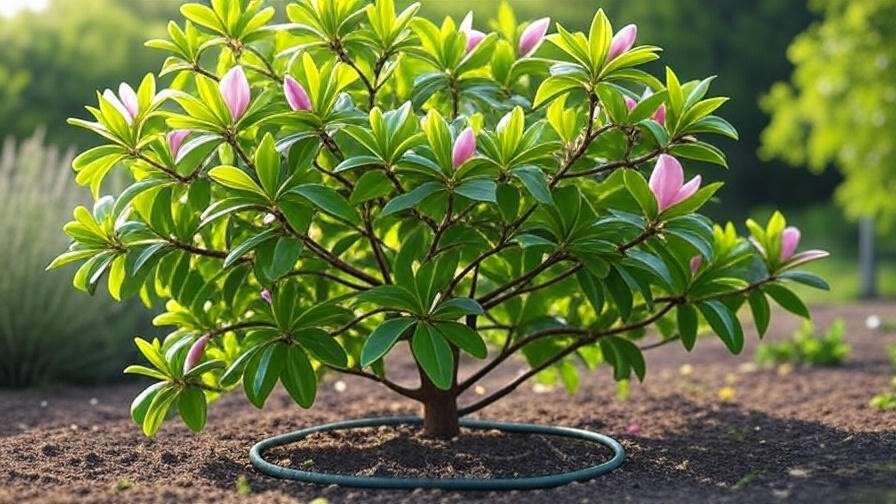
How to Water Properly
Follow these steps for optimal magnolia tree watering:
- Check Soil Moisture: Insert a finger or moisture meter 2–3 inches into the soil near the tree’s base. If it’s dry, proceed with watering.
- Water Slowly: Apply water at the tree’s base, focusing on the drip line, not the trunk. Use a soaker hose or drip system for even distribution.
- Ensure Deep Penetration: Water until the soil is moist to the recommended depth (12–18 inches for mature trees). This may take 20–30 minutes for larger trees.
- Apply Mulch: Spread 2–4 inches of organic mulch (e.g., bark or wood chips) around the tree, keeping it 2 inches away from the trunk to prevent rot. Mulch retains moisture and regulates soil temperature.
Weekly Watering Checklist:
- Check soil moisture before watering.
- Use a slow-drip method to avoid runoff.
- Confirm water reaches the root zone.
- Reapply mulch if it thins out.
Monitoring and Adjusting
Healthy magnolias display glossy, vibrant leaves and steady growth. If you notice dull foliage or slow growth, reassess your watering routine. Use a moisture meter for precision, or rely on visual cues like leaf texture. Adjust watering based on weather changes—reduce during rainy periods and increase during droughts. Regular monitoring ensures your magnolia gets just the right amount of water.
Common Magnolia Tree Watering Mistakes to Avoid 🚫
Overwatering and Its Consequences
Overwatering is one of the most common mistakes gardeners make with magnolia trees. Excess water can suffocate shallow roots, leading to root rot, a condition where roots decay and lose their ability to absorb nutrients. Symptoms include yellowing leaves, soft or mushy roots, and fungal growth near the trunk. To fix an overwatered magnolia, reduce watering frequency, improve soil drainage by adding organic matter, and ensure mulch isn’t piled against the trunk. If root rot is severe, consult an arborist to assess the tree’s health. According to a study from the University of Georgia Extension, overwatering accounts for nearly 30% of magnolia health issues in home gardens.
Underwatering and Drought Stress
On the flip side, underwatering can cause drought stress, particularly in young magnolias or during hot, dry spells. Signs include wilting leaves, leaf drop, or cracked soil around the tree’s base. A gardener I worked with in Texas noticed her Star Magnolia’s leaves curling during a summer drought. By implementing deep watering every three days and adding mulch, the tree recovered within weeks. To address underwatering, gradually rehydrate the tree over several days to avoid shocking the roots, and maintain a consistent schedule moving forward.
Ignoring Environmental Factors
A one-size-fits-all watering schedule can harm magnolias if it doesn’t account for local conditions. For instance, heavy rainfall may eliminate the need for supplemental watering, while a heatwave demands extra moisture. Failing to adjust for soil type or climate can lead to over- or underwatering. A case study from the North Carolina State Extension highlights a gardener who revived a struggling magnolia by tailoring watering to local rainfall patterns, reducing irrigation during wet seasons, and increasing it during dry spells. Always monitor weather and soil conditions to fine-tune your approach.
Advanced Tips for Magnolia Tree Watering Mastery 🌟
Using Mulch to Optimize Moisture Retention
Mulch is a game-changer for magnolia care, as it helps retain soil moisture, regulates temperature, and reduces weed competition. Organic mulches like bark, wood chips, or pine straw are ideal. Apply a 2–4-inch layer around the tree, extending to the drip line, but keep it 2 inches away from the trunk to prevent rot. Replenish mulch annually to maintain its benefits. For example, a client in Virginia saw her magnolia’s health improve significantly after adding a thick layer of pine bark mulch, which reduced watering frequency by 20%.
How to Apply Mulch Correctly:
- Clear weeds and debris from the tree’s base.
- Spread mulch evenly, 2–4 inches deep, avoiding the trunk.
- Check annually and add more mulch as needed.
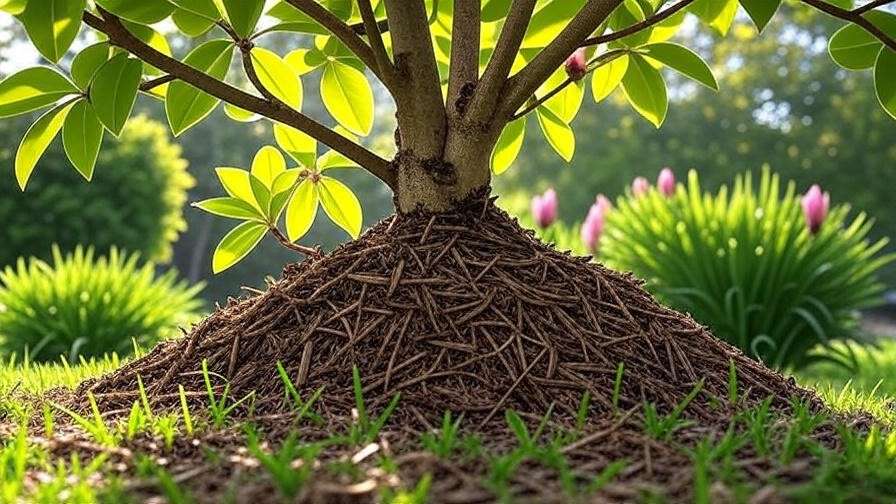
Incorporating Rainwater Harvesting
Using rainwater is an eco-friendly way to water magnolias, as it’s free of chemicals like chlorine found in tap water. Install a rain barrel under a downspout to collect runoff, and use it during dry periods. Rainwater is especially beneficial for magnolias, which prefer slightly acidic soils. A study by the Royal Horticultural Society found that trees watered with rainwater showed improved growth compared to those watered with treated tap water. Plus, harvesting rainwater reduces your water bill and supports sustainable gardening.
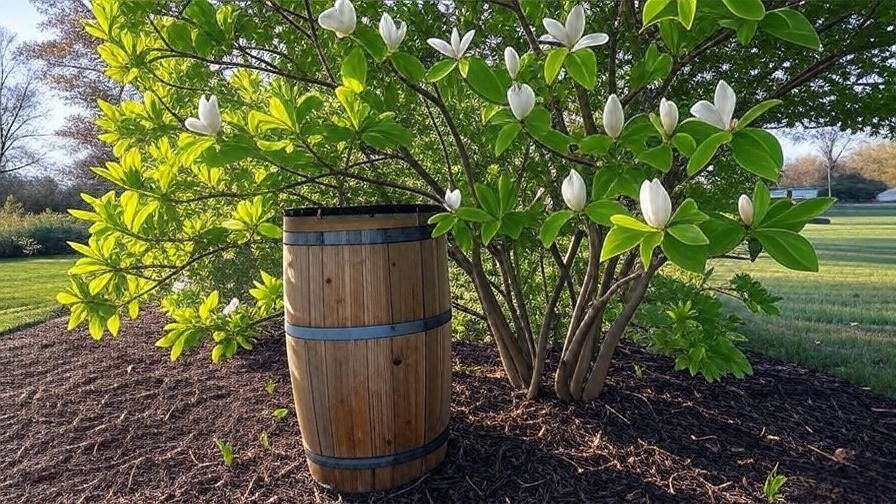
Adjusting for Extreme Weather
Extreme weather—droughts, heavy rains, or heatwaves—requires adaptive watering strategies. During droughts, increase watering frequency and use mulch to lock in moisture. After heavy rains, check for waterlogged soil and pause irrigation until the soil dries out. In heatwaves, water early in the morning and monitor for signs of stress like leaf scorch. Dr. Emily Carter, a horticulturist at Cornell University, notes, “Climate change is making weather patterns less predictable, so gardeners must stay vigilant and adjust watering to protect magnolias from stress.”
Troubleshooting Magnolia Tree Watering Issues 🛠️
Diagnosing Water-Related Problems
Identifying watering issues early can save your magnolia from long-term damage. Use this diagnostic chart to pinpoint problems:
| Symptom | Likely Cause | Solution |
|---|---|---|
| Yellowing leaves | Overwatering or poor drainage | Reduce watering, improve drainage |
| Wilting or curling leaves | Underwatering or drought stress | Increase watering frequency, deep water |
| Brown leaf edges | Drought or salt buildup from tap water | Flush soil with rainwater, water deeply |
| Fungal growth near trunk | Overwatering or mulch against trunk | Remove mulch from trunk, reduce watering |
If symptoms persist, take a soil sample to your local extension service for analysis. They can identify nutrient deficiencies or pH issues affecting water uptake.
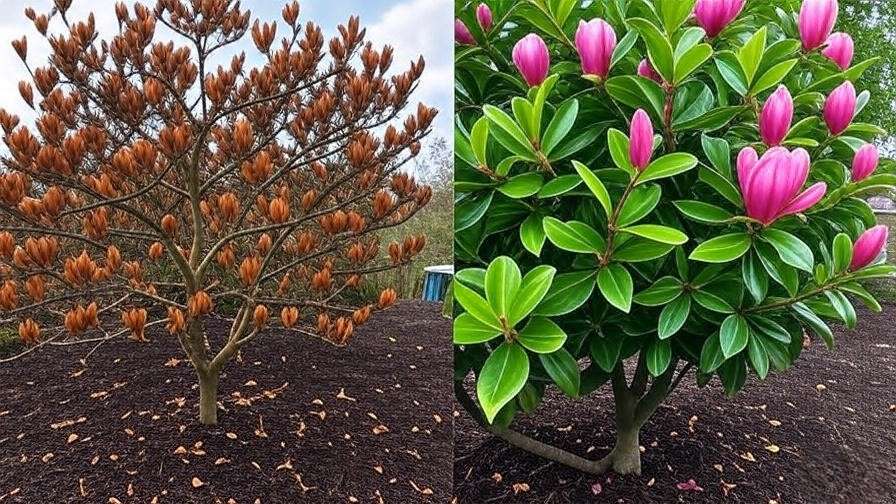
When to Seek Professional Help
While most watering issues can be resolved at home, severe problems like advanced root rot or persistent decline may require an arborist. Signs to watch for include significant leaf drop, soft trunk tissue, or no new growth for an entire season. Contact a certified arborist through trusted resources like the International Society of Arboriculture (ISA) or your local cooperative extension. They can provide specialized diagnostics and treatments to restore your magnolia’s health.
FAQs About Magnolia Tree Watering ❓
Q1: How do I know if my magnolia tree is getting enough water?
A: Check soil moisture 2–3 inches deep near the drip line. If it’s moist but not soggy, your tree is likely well-hydrated. Look for glossy leaves and steady growth as signs of proper watering.
Q2: Can I use a sprinkler to water my magnolia tree?
A: Sprinklers are less effective, as they wet foliage and waste water through evaporation. Use a soaker hose or drip irrigation for targeted, efficient watering.
Q3: What should I do if my magnolia’s leaves are turning yellow?
A: Yellow leaves often indicate overwatering or poor drainage. Test soil moisture and drainage, reduce watering if needed, and amend soil with compost to improve structure.
Q4: How does mulching help with magnolia tree watering?
A: Mulch retains soil moisture, reduces evaporation, and keeps roots cool. Apply 2–4 inches of organic mulch, keeping it away from the trunk, to optimize watering efficiency.
Q5: Is rainwater better than tap water for magnolias?
A: Rainwater is ideal, as it’s naturally soft and free of chemicals. Use a rain barrel to collect water, especially in areas with hard or treated tap water.
Conclusion 🌼
Mastering magnolia tree watering is the key to unlocking the full potential of these stunning ornamental trees. By understanding their unique needs, tailoring your approach to your environment, and avoiding common mistakes, you can ensure your magnolia thrives with lush foliage and vibrant blooms. Implement the strategies in this guide—deep watering, proper mulching, and seasonal adjustments—and monitor your tree regularly to keep it healthy year-round. As a horticulturist, I’ve seen countless magnolias flourish with these techniques, and I’m confident you’ll see the same results.
Ready to transform your magnolia into a garden centerpiece? Start applying these tips today, and share your success stories in the comments below! For more tree care insights, explore our articles on pruning magnolias or choosing the best fertilizers. 🌸

